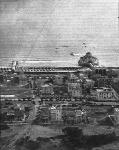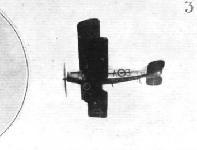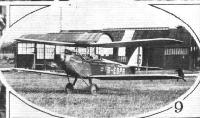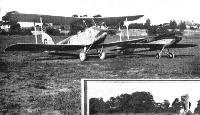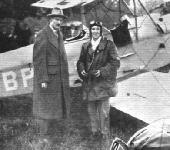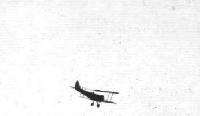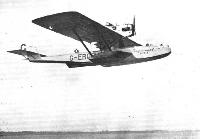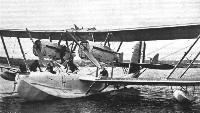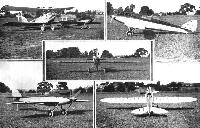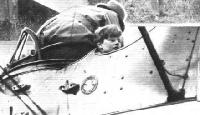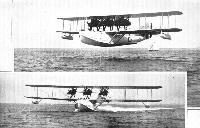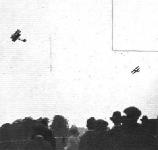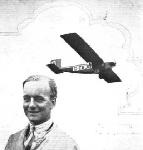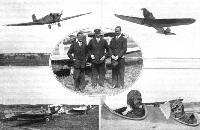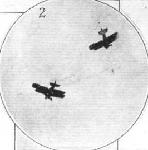Фотографии
-
THE R.A.F. DISPLAY: Event No. 1. Air Drill by Day-bombing Squadrons. This was staged to show the improvement in performance of modern machines. 1 shows a formation of D.H.9A's.
Самолёты на фотографии: De Havilland D.H.9A - Великобритания - 1918
-
EVENT 9, AN AIR ATTACK ON LONDON: The upper shows an "enemy" squadron of day-bombers (D.H.9's) arriving.
Самолёты на фотографии: De Havilland D.H.9A - Великобритания - 1918
-
THE R.A.F. DISPLAY: Event No. 1. Air Drill by Day-bombing Squadrons. This was staged to show the improvement in performance of modern machines. 4, shows some of the D.H.9A's taking off in formation.
Самолёты на фотографии: De Havilland D.H.9A - Великобритания - 1918
-
PINEDO ARRIVES HOME: A snapshot, taken from one of the escorting seaplanes, of the Marchesse de Pinedo landing in the "Santa Maria II" at Ostia, near Rome, on June 16, at the conclusion of his wonderful flight, Italy-America-Italy.
Самолёты на фотографии: Savoia-Marchetti / SIAI S.55 - Италия - 1924
-
Opening of Seville - Lisbon - Madrid Air Line: H.R.H. The Prince of Wales descending from the Junkers G.24 monoplane belonging to the "Union Aerea Espaniola," on the occasion of the inauguration of the new service recently.
Самолёты на фотографии: Junkers G 23 / G 24 - Германия - 1924
-
IN A HURRY: Two views of the new Bristol "Bulldog," with Bristol "Jupiter" engine. The lower photograph shows the neat engine cowling. The machine was piloted by Mr. C. F. Uwins.
Bristol test pilot Cyril Uwins flying the prototype Bulldog at Filton in July 1927.Самолёты на фотографии: Bristol Bulldog - Великобритания - 1927
-
NEW ALL-BRISTOL COMBINATION. Three views of the "Bulldog" with "Jupiter" engine, a single-seater fighter of recent production. Rounding the sheds unexpectedly is one of Mr. Uwins' tricks, and is illustrated here.
Самолёты на фотографии: Bristol Bulldog - Великобритания - 1927
-
THE MORNING'S PROGRAMME: 3, A "Brisfit" in the message-picking-up demonstration.
Самолёты на фотографии: Bristol F.2A/F.2B Fighter - Великобритания - 1916
-
THE BIRMINGHAM AIR PAGEANT: The "Siskins" from No. 41 Squadron in the machine park.
Самолёты на фотографии: Armstrong Whitworth Siskin - Великобритания - 1921
-
EVENT NO. 3: Air Manoeuvres to Music. In the upper photograph: "Here we go round the Mulberry Bush." On the left: "Chick, Chick, Chicken." Unfortunately, the "eggs" were white, and do not show against the sky. Below: Returning to the tune of "Bill Bailey, will you please come home." The machines are Armstrong-Whitworth "Siskins" from No. 41 (Fighter) Squadron.
Самолёты на фотографии: Armstrong Whitworth Siskin - Великобритания - 1921
-
THE BIRMINGHAM AIR PAGEANT: Air Drill by No. 41 Squadron (Siskins) under Sq.-Ldr. F. Sowrey. In this event the Squadron repeated several of the manoeuvres they carried out to music at the R.A.F. Display at Hendon.
Самолёты на фотографии: Armstrong Whitworth Siskin - Великобритания - 1921
-
THE MORNING'S PROGRAMME: 4, Start of the altitude race between "Gamecocks" and "Siskins."
Самолёты на фотографии: Armstrong Whitworth Siskin - Великобритания - 1921Gloster Gamecock - Великобритания - 1925
-
The Birmingham Air Pageant: The Lord Mayor of Birmingham (Alderman A. H. James) and the Lady Mayoress about to emplane on the Argosy air liner "City of Birmingham'' for a flight over the city.
Самолёты на фотографии: Armstrong Whitworth Argosy - Великобритания - 1926
-
Регистрационный номер: G-EBOH TO 18,000 FT.: The Honourable Lady Bailey (right), accompanied by Mrs. Geoffrey de Havilland, last week succeeded in establishing a new world's record for light 'planes by ascending to 18,000 ft. in a De Havilland "Moth X."
Самолёты на фотографии: De Havilland Moth / D.H.60 - Великобритания - 1925
-
Регистрационный номер: G-EBPR DE HAVILLAND SPORTS: Some snaps from a highly successful meeting. Giving 2s. 6d. joy rides on a "Moth"
Самолёты на фотографии: De Havilland Moth / D.H.60 - Великобритания - 1925
-
THE NEW DE HAVILLAND "TIGER MOTH" WITH DE HAVILLAND ENGINE: The photograph of the new machine standing next to a standard "Moth X" serves to indicate how almost absurdly small is the "Tiger Moth."
Самолёты на фотографии: De Havilland Moth / D.H.60 - Великобритания - 1925
-
THE MARCHIONESS OF TOWNSHEND'S AERIAL FETE: In the picture is Lord Ossulston (in flying gear) with the Lord Mayor of Norwich, Mr. C. R. Bignold, whom he flew back to Norwich to keep an appointment.
Самолёты на фотографии: De Havilland Moth / D.H.60 - Великобритания - 1925
-
THE MARCHIONESS OF TOWNSHEND'S AERIAL FETE: The "Moth," piloted by Capt. Lines, chasing balloons.
Самолёты на фотографии: De Havilland Moth / D.H.60 - Великобритания - 1925
-
Регистрационный номер: G-EBRL [2] Выпуск Widgeon осуществлялся в 1927-1928 годы. Компания «Westland» завершила его выпуск для того, чтобы сосредоточиться на выпуске самолетов Wapiti. Этот G-EBRL представлял собой вариант Widgeon Mk III.
TWO VIEWS OF THE WESTLAND "WIDGEON III" IN FLIGHT: Piloted by Mr. R. Brooke-Tapp. The upper picture gives a good idea of the excellent view from the pilot's cockpit.Самолёты на фотографии: Westland Widgeon - Великобритания - 1924
-
THE WESTLAND "WIDGEON III": Front view. The engine is a "Cirrus," Mark II.
Самолёты на фотографии: Westland Widgeon - Великобритания - 1924
-
Cockpits of the Westland "Widgeon III": Note the door giving access to the front cockpit. Also the luggage compartment in the deck fairing.
Самолёты на фотографии: Westland Widgeon - Великобритания - 1924
-
Регистрационный номер: G-EBRL [2] THE WESTLAND "WIDGEON III": Three-quarter rear view.
Самолёты на фотографии: Westland Widgeon - Великобритания - 1924
-
THE WESTLAND "WIDGEON III": Details of the two types of engine mountings which have been standardised. 1, shows the welded steel tube mounting for a "Cirrus" engine, with a more detailed view of a front engine bracket in 2. The mounting for the "Genet" engine is shown in 3, with details of the Duralumin face-plate in 4. Sketches A, B, C and D refer to details at corresponding points of 3.
Самолёты на фотографии: Westland Widgeon - Великобритания - 1924
-
THE WESTLAND "WIDGEON III": Some constructional details. 1, shows the manner of fairing the wing strut attachment with papier mache, the actual metal fitting being shown in 2. A typical fuselage joint is illustrated in 3, while 4 shows the attachment of lift struts to lower fuselage longeron. The hinge on the rear wing spar is shown in 5. This engages with a corresponding fitting on the centre-section, and forms the hinge for folding the wings.
Самолёты на фотографии: Westland Widgeon - Великобритания - 1924
-
Westland "Widgeon III" "Cirrus II" or Armstrong Siddeley "Genet" Engine
Самолёты на фотографии: Westland Widgeon - Великобритания - 1924
-
THE PRAGUE AERO SHOW: The Vojenska "Letov" S-20. This is a single-seater fighter, fitted with a 300 h.p. Hispano-Suiza engine.
Самолёты на фотографии: Letov S-20 - Чехословакия - 1925
-
AN ITALIAN SERVICE FLIGHT: One incident during General Balbo's (Italian Under-Secretary for Air) air tour of the stations on the Egean Sea, and in Cirenaica and Tripolitania. Inspecting an Escadrille of Capronis and Ansaldos at Berka (Bengazi).
Самолёты на фотографии: Ansaldo A-300 - Италия - 1919Caproni Ca.73 / Ca.80 - Италия - 1924
-
Регистрационный номер: G-EBQO [2] ANGLO-GERMAN CO-OPERATION: Capt. Frank Courtney making a test flight at Calshot on the Dornier "Wal" with Napier "Lion" engines on which he is hoping to attempt a flight from England to America and back. Unfavourable weather conditions are at present delaying the start.
Самолёты на фотографии: Dornier Do.J Wal - Германия - 1922
-
AN UNLUCKY PORTUGUESE FLIGHT: Maj. Sarmento de Beires left Lisbon on March 3, in a Dornier Wal flying boat, "Argus," intending to make a flight across the Atlantic and back. He succeeded in crossing from Baloma to Brazil, but last month the seaplane was lost whilst flying from Para to Georgetown (B.G.). Our pictures show (top, left) the "Argus" arriving at Rio de Janeiro (note Sugar Loaf Mt.), and Dr. Washington Luiz, the Brazilian President, and Maj. de Beires (right) when the President and party (bottom) were taken for a joy-ride.
Самолёты на фотографии: Dornier Do.J Wal - Германия - 1922
-
Регистрационный номер: G-EBQO [2] THE ENGLAND-AMERICA-ENGLAND FLIGHT: This photograph shows the Dornier Wai on which Capt. Frank Courtney, Flight-Lieut. Downer and Mr. Little are to attempt the double crossing of the Atlantic. The engines are Napier "Lions."
Самолёты на фотографии: Dornier Do.J Wal - Германия - 1922
-
THE R.A.F. DISPLAY: Bombing of the Village of "Hunyadi Janos in Irquestine." 1, shows the effect of the first bombs, dropped by Fairey "Foxes." In 2, after further attacks, the village is well alight
Самолёты на фотографии: Fairey Fox - Великобритания - 1925
-
THE R.A.F. DISPLAY: Event No. 1. Air Drill by Day-bombing Squadrons. This was staged to show the improvement in performance of modern machines. 3, shows a flight of Fairey "Foxes" approaching the enclosures in formation.
Самолёты на фотографии: Fairey Fox - Великобритания - 1925
-
FOR EVENT NO. 1: A squadron of Fairey "Foxes" taxying out in readiness for the exhibition of air drill by three day bombing squadrons.
Самолёты на фотографии: Fairey Fox - Великобритания - 1925
-
Регистрационный номер: N179, G-EBUP A NEW ALL-METAL FLYING BOAT: This photograph shows the Short "Singapore" with two Rolls-Royce "Condor" engines. As the machine is a service type (reconnaissance) details may not be published, but the "Singapore," in addition to being all-metal except for the wing covering, is claimed definitely to be able to fly with one engine stopped, even when carrying full load. The freedom from water soakage attained with a metal hull increases the useful load very materially, while the anti-corrosion treatment has now been found very effective, with consequent gain in the life of a machine.
Самолёты на фотографии: Short Singapore I / S.5 - Великобритания - 1926
-
Регистрационный номер: G-EBSD The Avro "Alpha-Avian" is fitted with the new Avro Alpha engine.
Самолёты на фотографии: Avro Avian / Type 594/616 - Великобритания - 1926
-
Регистрационный номер: G-EBRS A Useful Flight: Mrs. Eliott-Lynn beside her new machine, an Avro "Avian," Mk.II, at the Woodford Aerodrome, from which she started on her 1,200-mile flight at dawn on July 19, making 79 landings on the way and finishing the same night at Newcastle.
Самолёты на фотографии: Avro Avian / Type 594/616 - Великобритания - 1926
-
Регистрационный номер: G-EBRR ONE OF THE AIR LEAGUE CUP COMPETITORS: Mr. Cantrill (Lancashire Ae.C.) starts off for Woodford on the new Avro "Avian" ("Cirrus II").
Самолёты на фотографии: Avro Avian / Type 594/616 - Великобритания - 1926
-
THE MARCHIONESS OF TOWNSHEND'S AERIAL FETE: The young Marquis of Townshend selling a programme to Mr. Bert Hinkler
Самолёты на фотографии: Avro Avian / Type 594/616 - Великобритания - 1926
-
THE R.A.F. DISPLAY: Bombing of the Village of "Hunyadi Janos in Irquestine." In 3, even the church has caught (in spite of the official programme). Vickers "Victorias" are seen in 3, alighting with troops and machine gun while 4 illustrates how food and medicine is dropped by parachute. Troops are deplaning in 5, and getting ready to take part in the fight, and finally, women and children are taken away to safety by the "Victorias" in 6.
Самолёты на фотографии: Vickers Victoria - Великобритания - 1922
-
THE NEW DE HAVILLAND "TIGER MOTH" WITH DE HAVILLAND ENGINE: These four views give a good idea of the extremely clean lines of this miniature racer. The photograph of the new machine standing next to a standard "Moth X" serves to indicate how almost absurdly small is the "Tiger Moth." The only struts in the machine are the undercarriage Vees. For the rest the bracing is by Rafwire.
Самолёты на фотографии: De Havilland Tiger Moth / D.H.71 - Великобритания - 1927
-
THE BIRMINGHAM AIR PAGEANT: One of the "Grebes" from No. 25 Squadron "converging" on the tank in the bombing attack.
Самолёты на фотографии: Gloster Grebe - Великобритания - 1923
-
EVENT 9, AN AIR ATTACK ON LONDON: An "enemy" squadron of day-bombers (D.H.9's) are followed by another squadron of "enemy" machines (Vickers "Virginias" night-bombers), which are being attacked by defending single-seater fighters (Gloster "Grebes"), and one is seen "in flames."
Самолёты на фотографии: Gloster Grebe - Великобритания - 1923Vickers Virginia - Великобритания - 1922
-
DEPARTURE OF THE NIGHT BOMBERS: Below some of the "Virginias" taxying up for event 7. On the right, the three squadrons in flight, No. 7 (Worthydown) in the lead, followed by No. 9 (Manston) and No. 58 (Worthydown).
Самолёты на фотографии: Vickers Virginia - Великобритания - 1922
-
Регистрационный номер: J7745 THE HANDLEY PAGE "HINAIDI": This machine, fitted with Bristol geared "Jupiter" engines, was the only one taking part in the Display of which no photograph was available for inclusion in our issue of last week.
Самолёты на фотографии: Handley Page Hyderabad/H.P.24 / Hinaidi/H.P.33 / Clive/H.P.35 - Великобритания - 1923
-
THE MARCHIONESS OF TOWNSHEND'S AERIAL FETE: The young Marquis of Townshend seen here, a little too short for the Fairey "Fawn," cockpit.
Самолёты на фотографии: Fairey Pintail / Fawn - Великобритания - 1920
-
Регистрационный номер: H-NAQU A VERY FINE COMMERCIAL AEROPLANE: This Fokker F.VIII, fitted with two Bristol "Jupiter" Series VI engines, has one of the most comfortable cabins ever provided in a commercial machine.
Самолёты на фотографии: Fokker F.VIII - Нидерланды - 1927
-
THE PRAGUE AERO SHOW: The Vojenska "Letov" S-18, a training biplane of wood construction fitted with a 60 h.p. Walter engine.
Самолёты на фотографии: Letov S-18 / S-118 / S-218 Smolik - Чехословакия - 1925
-
Регистрационный номер: J8673 [4] THE GLOSTER "GORAL": Side view.
Самолёты на фотографии: Gloster Goral - Великобритания - 1927
-
Регистрационный номер: J8673 [4] THE GLOSTER "GORAL": Three-quarter front view. The engine is a Bristol "Jupiter."
Самолёты на фотографии: Gloster Goral - Великобритания - 1927
-
Регистрационный номер: J8673 [4] THE GLOSTER "GORAL" BRISTOL "JUPITER": Three views of the machine in flight, piloted by Flying-Officer Howard Saint, D.S.C.
Самолёты на фотографии: Gloster Goral - Великобритания - 1927
-
Регистрационный номер: J8673 [4] THE GLOSTER "GORAL": Three-quarter rear view.
Самолёты на фотографии: Gloster Goral - Великобритания - 1927
-
Регистрационный номер: N186 A REAL FLYING SHIP: These two views show the Saunders "Valkyrie," with three Rolls-Royce "Condor" engines, in flight and "planing." The clean running should be noted. The "Valkyrie" represents one more step towards the flying cruiser of the future.
Самолёты на фотографии: Saunders Valkyrie / A.3 - Великобритания - 1926
-
THE MARCHIONESS OF TOWNSHEND'S AERIAL FETE: The mimic battle between the Gloucester "Gamecock" and the Vickers "Venture."
Самолёты на фотографии: Gloster Gamecock - Великобритания - 1925Vickers Vixen / Venture / Valparaiso / Valiant - Великобритания - 1923
-
Регистрационный номер: G-EBJO THE BIRMINGHAM AIR PAGEANT: The winner of the Air League Challenge Cup, Mr. Norman Jones, and his A.N.E.C. II monoplane (Bristol "Cherub II").
Самолёты на фотографии: ANEC I / II - Великобритания - 1923
-
THE MORNING'S PROGRAMME: 1, Aerobatics on an "Avro-Lynx."
Самолёты на фотографии: Avro Avro 504N - Великобритания - 1920
-
Регистрационный номер: G-EBKQ FLYING BETWEEN SERMONS: By using an Avro aeroplane the Bishop of Willochra, S. Australia, who attended the Anglo-Catholic Conference in London, was able to preach in London on Sunday morning last, and in Manchester in the afternoon, Our photograph shows the Bishop at Woodford after landing. His pilot was Mr. Goodfellow, of the Lancashire Aero Club. The machine left London at 1 p.m. and landed at Manchester at 2.30 p.m.
Самолёты на фотографии: Avro Avro 504N - Великобритания - 1920
-
THE BIRMINGHAM AIR PAGEANT: Three Avro-Lynx "bombers" from No. 605 County of Warwick Squadron attempt to blow up an Eastern Castle Bromwich.
Самолёты на фотографии: Avro Avro 504N - Великобритания - 1920
-
GERMAN LIGHT 'PLANES VISIT ENGLAND: These photographs show the Klemm-Daimler L.20 machines on the ground and in flight. In the lower right-hand corner Lady Bailey is seen at the start of a flight with Herr Lusser. In the centre the three German pilots who visited this country. They are, from left to right, Herr Lusser, Herr Siebel, and Herr Lorzer.
Самолёты на фотографии: Daimler L 20 - Германия - 1924
-
Регистрационный номер: NX237 [2] ATLANTIC FLYERS ARRIVE AT CROYDON: The photograph in the top left-hand corner shows the Bellanca monoplane crossing the aerodrome at low altitude while in the bottom right-hand corner it is seen at the moment of alighting. Above, Mr. Chamberlin is seen descending from the machine, and below, on the left, the famous pilot is introducing Mr. Levine to his mother.
Самолёты на фотографии: Wright-Bellanca WB-1 / WB-2 - США - 1925
-
Регистрационный номер: NX237 [2] THE WRIGHT-BELLANCA MONOPLANE AT CROYDON: The upper photograph shows the general appearance of the New York-Cottbus monoplane, while in the lower may be seen in more detail the Wright "Whirlwind" engine, the pilot's cockpit and wind screen, and a corner of the large petrol tank.
Самолёты на фотографии: Wright-Bellanca WB-1 / WB-2 - США - 1925
-
THE DE HAVILLAND "HOUND": This machine has been said to be "too good" for a General-Purpose type, and may be transferred to a different class. Performance figures may not be given, but the "Hound" is believed to have excellent speed, climb and ceiling. The engine is a Napier "Lion."
Самолёты на фотографии: De Havilland Hound / D.H.65 - Великобритания - 1926
-
THE DE HAVILLAND "HOUND" IN ACTION: Two photographs of a new D.H. with Napier "Lion." When the photographs were taken the machine was piloted by Capt. Hubert Broad.
Самолёты на фотографии: De Havilland Hound / D.H.65 - Великобритания - 1926
-
Регистрационный номер: J8820 A "Genet-Moth" performing the unusual stunt of "skating" across the aerodrome on the side of its fuselage.
Самолёты на фотографии: De Havilland Genet Moth - Великобритания - 1926
-
Регистрационный номер: J8816, J8818, G-EDCA THE BIRMINGHAM AIR PAGEANT: The first R.A.F. event at the Pageant was a display of simultaneous aerobatics by five "Genet-Moths" from the Central Flying School. The lower picture shows them taking off while the top picture shows how close each machine was to the other.
Самолёты на фотографии: De Havilland Genet Moth - Великобритания - 1926
-
AEROBATICS BY "GENET-MOTHS": Five instructors from the Central Flying School "evoluting" together. In the upper photograph the machines are just commencing a loop. On the right they are seen upside down. Below, in formation.
Самолёты на фотографии: De Havilland Genet Moth - Великобритания - 1926
-
"THE DOUBLE BUNT:" The "Genet-Moths'" turn at the Birmingham Pageant. In the large picture the "Moths" are seen turning upside down after diving - the machine on extreme right is just turning over from the dive. Inset, a simultaneous half-roll.
Самолёты на фотографии: De Havilland Genet Moth - Великобритания - 1926
-
"LET'S ALL GO MAD": Sq.-Ldr. J. Noakes is seen "crabbing" on a "Genet-Moth."
Самолёты на фотографии: De Havilland Genet Moth - Великобритания - 1926
-
THE MORNING'S PROGRAMME: 2, Duel between two Gloster "Gamecocks" from No. 23 (Fighter) squadron. The machines were piloted by F/O. F. F. Wilkinson and F O. H. C. G. Dauncey respectively.
Самолёты на фотографии: Gloster Gamecock - Великобритания - 1925
Статьи
- Flight



